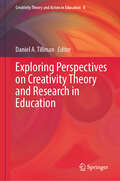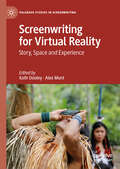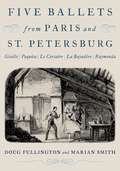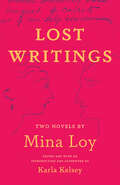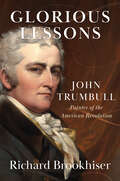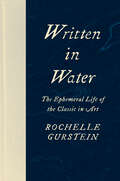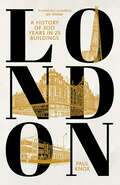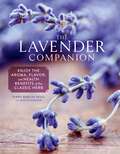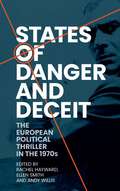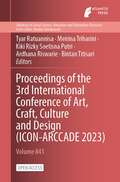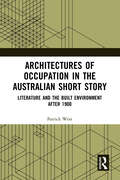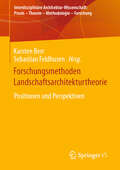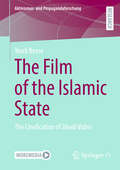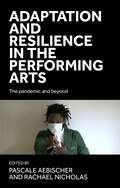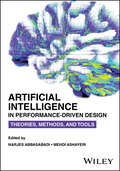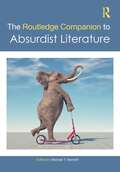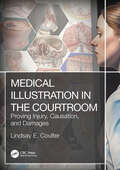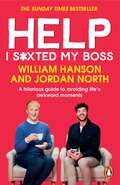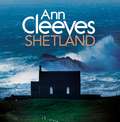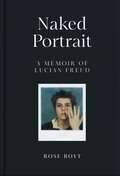- Table View
- List View
Exploring Perspectives on Creativity Theory and Research in Education (Creativity Theory and Action in Education #8)
by Daniel A. TillmanCollectively, the sixteen chapters in this book investigate the power of creativity in the classroom, many through the specific lens of limited resources as an opportunity. The chapters are divided into two sections, eight chapters comprising Section I: Theory and Research and then the eight chapters comprising Section II: Additional Perspectives and Future Directions. Within these two sections, the more than two-dozen authors that contributed to this book tackle a wide range of the possibilities for designing creative classroom-based instruction wherein limited resources are highlighted and valued, rather than avoided or lamented. The two main sections of this book are each preceded by a brief introductory summary highlighting those sections’ attributes and objectives, with the intention of providing helpful structure to the reader—but the book has also been designed such that each chapter stands independently and can be jumped to directly like a handbook. In its totality, this book exploring perspectives on creativity theory and research in education is designed to serve as a valuable resource for teachers, teacher educators, school administrators, parents, and education researchers, along with anyone else that is interested in optimizing our opportunities for nurturing creativity within classrooms.
Screenwriting for Virtual Reality: Story, Space and Experience (Palgrave Studies in Screenwriting)
by Kath Dooley Alex MuntThis book is focused on screenwriting and development for virtual reality (VR). It explores a diverse range of creative approaches to the writing and screen development of VR stories and immersive audience experiences. Contributions from scholars and practitioners combine conceptual and practically orientated approaches for creating fictional and documentary media VR stories. The book evaluates, challenges and adapts existing screenwriting models and practices for immersive storytelling and grapples with the future of storytelling in the era of sophisticated computer visualization, AI and the online social metaverse. The book proposes new VR storytelling models, identifies altered relationships between creators, screen works and their audiences and demonstrates how interdisciplinary practices will be core to the future of screen storytelling.
Five Ballets from Paris and St. Petersburg: Giselle | Paquita | Le Corsaire | La Bayad?re | Raymonda
by Marian Smith Doug FullingtonFive Ballets from Paris and St. Petersburg offers fascinating new looks at five classic story ballets: Giselle (1841), Paquita (1846), Le Corsaire (1856), La Bayad?re (1877), and Raymonda (1898), drawing on a treasure trove of manuscripts that offer explicit written information about how many nineteenth-century ballets were performed in their earliest incarnations. Bursting with details forgotten for more than a century, these manuscripts bring the ballets to life by disclosing steps, floor patterns, and mime conversations as well as valuable insight into how the music helped create the drama. Generously enriched with more than 50 images and more than 350 musical examples, the book also includes, in appendices, English translations of seven French and Russian librettos. Emerging from the plenteous new findings in this book is a fresh portrait of a living, breathing art form with strong audience appeal. Simply put, Five Ballets fills huge gaps in dance history, inviting both general readers and specialists to rethink the usual narratives about nineteenth-century ballet, its music, characters, and choreographies, its depictions of Others and Elsewhere, and the careers of its major choreographers. It also offers a rich resource to practitioners seeking to learn how the makers of these five classic ballets found such great success.
Lost Writings: Two Novels by Mina Loy
by Mina LoyTwo never-before-published novels by Mina Loy, the celebrated modernist poet, artist, and feminist Mina Loy (1882–1966) is an essential figure of the European and American modernist avant-garde. A groundbreaking writer of poetry, novels, essays, plays, and uncategorizable prose, she was also a fashion and lighting designer and an accomplished visual artist. As gallery agent for figures such as Giorgio de Chirico, Alberto Giacometti, and Salvador Dalí, she was a significant conduit for art that traversed the Atlantic. Loy has been best known for the poetry she published in the little magazines of the late teens and early twenties, most notably the long poem “Songs to Joannes” and the autobiographical verse-epic “Anglo-Mongrels and the Rose.” Featuring two never-before-published manuscripts of Loy’s autobiographical prose—The Child and the Parent and Islands in the Air—this remarkable book expands Loy’s rich oeuvre. Interlinked texts written over twenty years, from the 1930s to the 1950s, these fascinating works narrate the feminist struggle of the creative spirit as it comes into consciousness and encounters indoctrinating social norms. The works are accompanied by an introduction and afterword by Karla Kelsey that frame Loy as a poet, prose writer, businesswoman, and visual artist and discuss the texts, their stylistic innovations, and their unique interconnectedness.
Glorious Lessons: John Trumbull, Painter of the American Revolution
by Richard BrookhiserThe complicated life and legacy of John Trumbull, whose paintings portrayed both the struggle and the principles that distinguished America’s founding moment John Trumbull (1756–1843) experienced the American Revolution firsthand—he served as aid to George Washington and Horatio Gates, was shot at, and was jailed as a spy. He made it his mission to record the war, giving visual form to what most citizens of the new United States thought: that they had brought into the world a great and unprecedented political experiment. His purpose, he wrote, was “to preserve and diffuse the memory of the noblest series of actions which have ever presented themselves in the history of man.” Although Trumbull’s contemporaries viewed him as a painter, Trumbull thought of himself as a historian. Richard Brookhiser tells Trumbull’s story of acclaim and recognition, a story complicated by provincialism, war, a messy personal life, and, ultimately, changing fashion. He shows how the artist’s fifty-year project embodied the meaning of American exceptionalism and played a key role in defining the values of the new country. Trumbull depicted the story of self-rule in the modern world—a story as important and as contested today as it was 250 years ago.
Written in Water: The Ephemeral Life of the Classic in Art
by Rochelle GursteinA deeply personal yet broadly relevant exploration of the ephemeral life of the classic in art, from the eighteenth century to our own day Is there such a thing as a timeless classic? More than a decade ago, Rochelle Gurstein set out to explore and establish a solid foundation for the classic in the history of taste. To her surprise, that history instead revealed repeated episodes of soaring and falling reputations, rediscoveries of long-forgotten artists, and radical shifts in the canon, all of which went so completely against common knowledge that it was hard to believe it was true. Where does the idea of the timeless classic come from? And how has it become so fiercely contested? By recovering disputes about works of art from the eighteenth century to the close of the twentieth, Gurstein takes us into unfamiliar aesthetic and moral terrain, providing a richly imagined historical alternative to accounts offered by both cultural theorists advancing attacks on the politics of taste and those who continue to cling to the ideal of universal values embodied in the classic. As Gurstein brings to life the competing responses of generations of artists, art lovers, and critics to specific works of art, she makes us see the same object vividly and directly through their eyes and feel, in all its enlarging intensity, what they felt.
London: A History of 300 Years in 25 Buildings
by Paul KnoxA lively new history of London told through twenty-five buildings, from iconic Georgian townhouses to the Shard A walk along any London street takes you past a wealth of seemingly ordinary buildings: an Edwardian church, modernist postwar council housing, stuccoed Italianate terraces, a Bauhaus-inspired library. But these buildings are not just functional. They are evidence of London’s rich and diverse history and have shaped people’s experiences, identities, and relationships. In this engaging study, Paul L. Knox traces the history of London from the Georgian era to the present day through twenty-five surviving buildings. Knox explores where people lived and worked, from grand Regency squares to Victorian workshops, and highlights the impact of migration, gentrification, and inequality. We see famous buildings, like Harrods and Abbey Road Studios, and everyday places like Rochelle Street School and Thamesmead. Each historical period has introduced new buildings, and old ones have been repurposed. As Knox shows, it is the living history of these buildings that makes up the vibrant, but exceptionally unequal, city of today.
The Lavender Companion: Enjoy the Aroma, Flavor, and Health Benefits of This Classic Herb
by Jessica Dunham Terry Barlin VesciA celebration of lavender featuring stunning photographs; favorite recipes for the kitchen, pantry, and body care products; along with fascinating lore and gardening guidance from a destination lavender farm. Lavender has long been a favorite herb with its amazing, resinous fragrance; calming qualities; and unique flavor for seasoning food. This lavishly photographed celebration of the beloved herb, written by an acclaimed lavender farmer and cooking instructor, is brimming over with inspiration and ideas for bringing the fragrance and flavor of lavender into daily life. The book profiles the most popular lavender varieties and their recommended uses, along with the history, lore, and traditional medicinal uses. More than 40 recipes showcase lavender in delicious dishes from the kitchen as well homemade craft and body products. Tips for success with lavender in the garden complete this perfect gift for every lavender lover.
States of danger and deceit: The European political thriller in the 1970s
by Ellen Smith Rachel Hayward Andy WillisStates of danger and deceit places key films (Z (1969), The Mattei Affair (1972), State of Siege (1972), The Lost Honour of Katharina Blum (1975), Illustrious Corpses (1976)) and filmmakers (Costa-Gavras, Elio Petri, Francesco Rosi, Volker Schlöndorff) from across Europe into their historical, political and social contexts before considering the ways they have impacted upon politically engaged filmmakers since. Presented in a dossier format, made up of shorter engaging pieces, this volume offers a series of contextualisations and detailed explorations of significant examples of the political thriller from across Europe.
States of danger and deceit: The European political thriller in the 1970s
by Rachel Hayward, Ellen Smith and Andy WillisA HOME Film DossierStates of danger and deceit places key films (Z (1969), The Mattei Affair (1972), State of Siege (1972), The Lost Honour of Katharina Blum (1975), Illustrious Corpses (1976)) and filmmakers (Costa-Gavras, Elio Petri, Francesco Rosi, Volker Schlöndorff) from across Europe into their historical, political and social contexts before considering the ways they have impacted upon politically engaged filmmakers since. Presented in a dossier format, made up of shorter engaging pieces, this volume offers a series of contextualisations and detailed explorations of significant examples of the political thriller from across Europe.
Proceedings of the 3rd International Conference of Art, Craft, Culture and Design (Advances in Social Science, Education and Humanities Research #841)
This is an open access book. Globally, 2023 marks the mid-point of the 2030 UN Sustainable Development Goals agenda, yet we are still struggling to rebuild and respond to current conditions in every aspect. The future remains unpredictable and never have we been presented with such complexity as what we are facing today. As we continue to live in this age of Anthropocene, we carry on the legacy of being the cause of both destruction and rehabilitation. These ambiguous roles manifest on every occasion when we try to solve a problem. Consequently, we grow to feel more anxious and innovation seems to no longer be possible. Creativity is at the heart of what we do as artists, makers, and designers. For us, crisis creates opportunities to open up other pathways in this ever-changing world. With its fluidity, art, craft, culture, and design discipline has significant roles in facilitating changes everywhere through its capability to connect humans, nature, and everything in between. At this conference, we are inviting you to explore the theme of “Fluid & Ubiquitous”, which is elaborated into various sub-themes that encompass some key ideas: Care Systemic Design Cross-cultural Identity Object as an Agency Transmateriality
Architectures of Occupation in the Australian Short Story: Literature and the Built Environment after 1900
by Patrick WestPatrick West’s Architectures of Occupation in the Australian Short Story cultivates the potential for literary representations of architectural space to contribute to the development of a contemporary politics of Australian post-colonialism.West argues that the predominance of tropes of place within cultural and critical expressions of Australian post-colonialism should be re-balanced through attention to spatial strategies of anti-colonial power. To elaborate the raw material of such strategies, West develops interdisciplinary close readings of keynote stories within three female-authored, pan-twentieth century, Australian short-story collections: Bush Studies by Barbara Baynton (1902); Kiss on the Lips and Other Stories by Katharine Susannah Prichard (1932); and White Turtle: A Collection of Short Stories by Merlinda Bobis (1999). The capacity of the short-story form to prompt creative and politically germinal engagements with species of space associated with architecture and buildings is underscored. Relatedly, West argues that the recent resurgence of binary thought—on local, national, and international scales—occasions an approach to the short-story collections shaped by binary relationships like a dichotomy of inside and outside. Concluding his argument, West connects the literary and architectural critiques of the story collections to the wicked problem, linked to ongoing colonial violences, of improving Australian Indigenous housing outcomes.Innovative and interdisciplinary, this book will be of interest to scholars and students of Literary, Architectural, and Postcolonial Studies. .
Architectures of Occupation in the Australian Short Story: Literature and the Built Environment after 1900
by Patrick WestPatrick West’s Architectures of Occupation in the Australian Short Story cultivates the potential for literary representations of architectural space to contribute to the development of a contemporary politics of Australian post-colonialism.West argues that the predominance of tropes of place within cultural and critical expressions of Australian post-colonialism should be re-balanced through attention to spatial strategies of anti-colonial power. To elaborate the raw material of such strategies, West develops interdisciplinary close readings of keynote stories within three female-authored, pan-twentieth century, Australian short-story collections: Bush Studies by Barbara Baynton (1902); Kiss on the Lips and Other Stories by Katharine Susannah Prichard (1932); and White Turtle: A Collection of Short Stories by Merlinda Bobis (1999). The capacity of the short-story form to prompt creative and politically germinal engagements with species of space associated with architecture and buildings is underscored. Relatedly, West argues that the recent resurgence of binary thought—on local, national, and international scales—occasions an approach to the short-story collections shaped by binary relationships like a dichotomy of inside and outside. Concluding his argument, West connects the literary and architectural critiques of the story collections to the wicked problem, linked to ongoing colonial violences, of improving Australian Indigenous housing outcomes.Innovative and interdisciplinary, this book will be of interest to scholars and students of Literary, Architectural, and Postcolonial Studies. .
Forschungsmethoden Landschaftsarchitekturtheorie: Positionen und Perspektiven (Interdisziplinäre Architektur-Wissenschaft: Praxis – Theorie – Methodologie – Forschung)
by Karsten Berr Sebastian FeldhusenWie werden in Forschungsarbeiten in der Landschaftsarchitekturtheorie Erkenntnisse gewonnen? Um diese Frage zu beantworten, ist es sinnvoll, die Methode der Forschung einer individuellen Forschungsarbeit anschaulich zu machen. Ziel des Buchs ist es, eine Übersicht an aktuellen Forschungsmethoden im Feld der Landschaftsarchitekturtheorie zu geben. Damit möchte das Buch einen Beitrag zur Methodendiskussion in der Landschaftsarchitekturtheorie leisten, die häufig gefordert, aber selten geführt wird. Die Aufsätze in dem Buch sind untereinander formal und inhaltlich abgestimmt: Formal haben sie einen ähnlichen Aufbau, sodass die Methoden gut miteinander verglichen werden können. Inhaltlich sind die Aufsätze insofern miteinander abgestimmt, weil jeder Aufsatz für eine bestimmte Forschungsmethode in der Landschaftsarchitekturtheorie steht.
The Film of the Islamic State: The Cinefication of Jihadi Video (Aktivismus- und Propagandaforschung)
by Yorck BeeseThe film of the so-called Islamic State is part of the still relatively opaque history of radical Sunni Islamist video propaganda, a field in which it is simultaneously its strongest exponent. Through its imports of aesthetics in the age of digitalization and the concurrent de-professionalization of film, this violent propaganda film has interestingly drawn attention for its seeming likeness to Hollywood film, an odd comparison that the Islamic State itself opposes through its own filmic antagonisms to commercial cinema. In an intermittent attempt at attacking cinematic illusionism, it has made increasing use of cinematic devices in order to communicate its violent and anti-humanist ideology – and has thereby entered a state of filmic self-contradiction. This book analyzes and uncovers the mechanisms and dynamics of ideological communication in the Islamic State’s videos through a combined historical and neoformalist approach, making them predictable for future researchers.
Adaptation and resilience in the performing arts: The pandemic and beyond (The pandemic and beyond)
by Pascale Aebischer and Rachael NicholasThis book offers insights into some of the digital innovations, structural adaptations and analogue solutions that enabled live performance in the UK to survive through the COVID-19 pandemic. It provides evidence of values-led policies and practices that have improved the wellbeing of the creative workforce and have increased access to live performance. Through sections that address digital innovations, workforce resilience and programming live performances outdoors and in community settings, this book provides practical insights into the challenges live performance faced during the pandemic. It shows how, in order to survive, individuals and companies within the sector drew on the creativity and resourcefulness of its workforce, and on new and existing networks. In these accounts, the pandemic functioned as catalyst for technological innovations, stock-taking regarding exploitative industry structures, and a re-valuing of the role of live performance for community-building.
Adaptation and resilience in the performing arts: The pandemic and beyond (The pandemic and beyond)
by Pascale Aebischer Rachael NicholasThis book offers insights into some of the digital innovations, structural adaptations and analogue solutions that enabled live performance in the UK to survive through the COVID-19 pandemic. It provides evidence of values-led policies and practices that have improved the wellbeing of the creative workforce and have increased access to live performance. Through sections that address digital innovations, workforce resilience and programming live performances outdoors and in community settings, this book provides practical insights into the challenges live performance faced during the pandemic. It shows how, in order to survive, individuals and companies within the sector drew on the creativity and resourcefulness of its workforce, and on new and existing networks. In these accounts, the pandemic functioned as catalyst for technological innovations, stock-taking regarding exploitative industry structures, and a re-valuing of the role of live performance for community-building.
Artificial Intelligence in Performance-Driven Design: Theories, Methods, and Tools
by Narjes Abbasabadi Mehdi AshayeriA definitive, interdisciplinary reference to using artificial intelligence technology and data-driven methodologies for sustainable design Artificial Intelligence in Performance-Driven Design: Theories, Methods, and Tools explores the application of artificial intelligence (AI), specifically machine learning (ML), for performance modeling within the built environment. This work develops the theoretical foundations and methodological frameworks for utilizing AI/ML, with an emphasis on multi-scale modeling encompassing energy flows, environmental quality, and human systems. The book examines relevant practices, case studies, and computational tools that harness AI’s capabilities in modeling frameworks, enhancing the efficiency, accuracy, and integration of physics-based simulation, optimization, and automation processes. Furthermore, it highlights the integration of intelligent systems and digital twins throughout the lifecycle of the built environment, to enhance our understanding and management of these complex environments. This book also: Incorporates emerging technologies into practical ideas to improve performance analysis and sustainable design Presents data-driven methodologies and technologies that integrate into modeling and design platforms Shares valuable insights and tools for developing decarbonization pathways in urban buildings Includes contributions from expert researchers and educators across a range of related fields Artificial Intelligence in Performance-Driven Design is ideal for architects, engineers, planners, and researchers involved in sustainable design and the built environment. It’s also of interest to students of architecture, building science and technology, urban design and planning, environmental engineering, and computer science and engineering.
The Routledge Companion to Absurdist Literature (Routledge Literature Companions)
by Michael Y. BennettThe Routledge Companion to Absurdist Literature is the first authoritative and definitive edited collection on absurdist literature. As a field-defining volume, the editor and the contributors are world leaders in this ever-exciting genre that includes some of the most important and influential writers of the twentieth century, including Samuel Beckett, Harold Pinter, Edward Albee, Eugene Ionesco, Jean Genet, and Albert Camus. Ever puzzling and always refusing to be pinned down, this book does not attempt to define absurdist literature, but attempts to examine its major and minor players. As such, the field is indirectly defined by examining its constituent writers. Not only investigating the so-called “Theatre of the Absurd,” this volume wades deeply into absurdist fiction and absurdist poetry, expanding much of our previous sense of what constitutes absurdist literature. Furthermore, long overdue, approximately one-third of the book is devoted to marginalized writers: black, Latin/x, female, LGBTQ+, and non-Western voices.
The Routledge Companion to Absurdist Literature (Routledge Literature Companions)
by Michael Y. BennettThe Routledge Companion to Absurdist Literature is the first authoritative and definitive edited collection on absurdist literature. As a field-defining volume, the editor and the contributors are world leaders in this ever-exciting genre that includes some of the most important and influential writers of the twentieth century, including Samuel Beckett, Harold Pinter, Edward Albee, Eugene Ionesco, Jean Genet, and Albert Camus. Ever puzzling and always refusing to be pinned down, this book does not attempt to define absurdist literature, but attempts to examine its major and minor players. As such, the field is indirectly defined by examining its constituent writers. Not only investigating the so-called “Theatre of the Absurd,” this volume wades deeply into absurdist fiction and absurdist poetry, expanding much of our previous sense of what constitutes absurdist literature. Furthermore, long overdue, approximately one-third of the book is devoted to marginalized writers: black, Latin/x, female, LGBTQ+, and non-Western voices.
Medical Illustration in the Courtroom: Proving Injury, Causation, and Damages
by Lindsay E. CoulterMedical Illustration in the Courtroom: Proving Injury, Causation, and Damages educates the reader on how to communicate science visually—in personal injury, medical malpractice, criminal, and forensic cases—by creating art that utilizes medical records, radiographs, and computer software. Medical illustration bridges the gap between complex technical, medical, and scientific concepts to clearly illustrate, and explain visually, a medical condition, negligence, or the causation of an injury or death to the lay person. Medical artists are frequently challenged with illustrating injuries and medical conditions that can’t be seen by the naked eye. And while using medical photography and imaging for illustrative purposes can be helpful, to an untrained eye it can often be unclear or confusing. This is where the medical illustrator enters the equation. There are often patients who have recovered from an injury or infection that appear in good health. However, should an unforeseen injury or fatality happen, medical illustrators can reveal to people what’s actually going on inside the person, an invaluable asset to attorneys in the courtroom—especially for personal injury and medical malpractice cases. While many attorneys utilize medical artists, nonvisual people don’t always recognize the value of demonstrative aids until they see them first-hand.When attorneys and their clients enlist the aid of medical artists, it quickly becomes apparent that properly conceived and executed artwork is invaluable to illustrating the facts—and medical impacts—of any number of scenarios: homicides by shooting, stabbings, vehicular accidents, in addition to medical malpractice and personal injuries resulting from surgery or possible negligence.Presenting a myriad of services and computer technologies that can be utilized, Medical Illustration in the Courtroom provides demonstrative aids used in cases to illustrate personal injury and medical malpractice, employing "tricks of the trade" to create an accurate effective image. Such images are educational to attorneys, insurance adjusters, judges, and juries to help create a visual storyline, the goal being to help combine art and science to provide a clear illustration of events to help in adjudicate legal and forensic cases.
Medical Illustration in the Courtroom: Proving Injury, Causation, and Damages
by Lindsay E. CoulterMedical Illustration in the Courtroom: Proving Injury, Causation, and Damages educates the reader on how to communicate science visually—in personal injury, medical malpractice, criminal, and forensic cases—by creating art that utilizes medical records, radiographs, and computer software. Medical illustration bridges the gap between complex technical, medical, and scientific concepts to clearly illustrate, and explain visually, a medical condition, negligence, or the causation of an injury or death to the lay person. Medical artists are frequently challenged with illustrating injuries and medical conditions that can’t be seen by the naked eye. And while using medical photography and imaging for illustrative purposes can be helpful, to an untrained eye it can often be unclear or confusing. This is where the medical illustrator enters the equation. There are often patients who have recovered from an injury or infection that appear in good health. However, should an unforeseen injury or fatality happen, medical illustrators can reveal to people what’s actually going on inside the person, an invaluable asset to attorneys in the courtroom—especially for personal injury and medical malpractice cases. While many attorneys utilize medical artists, nonvisual people don’t always recognize the value of demonstrative aids until they see them first-hand.When attorneys and their clients enlist the aid of medical artists, it quickly becomes apparent that properly conceived and executed artwork is invaluable to illustrating the facts—and medical impacts—of any number of scenarios: homicides by shooting, stabbings, vehicular accidents, in addition to medical malpractice and personal injuries resulting from surgery or possible negligence.Presenting a myriad of services and computer technologies that can be utilized, Medical Illustration in the Courtroom provides demonstrative aids used in cases to illustrate personal injury and medical malpractice, employing "tricks of the trade" to create an accurate effective image. Such images are educational to attorneys, insurance adjusters, judges, and juries to help create a visual storyline, the goal being to help combine art and science to provide a clear illustration of events to help in adjudicate legal and forensic cases.
Help I S*xted My Boss: The Sunday Times Bestselling Guide to Avoiding Life’s Awkward Moments
by William Hanson Jordan North'Funny, filthy and fantastic. Cackled from start to finish' - Rylan ClarkHow do you ask your mate for that £50 back?When is OK to trump in front of your partner?And what should you do if you've accidentally sexted your boss?William and Jordan are from very different worlds.William's an etiquette expert, with his tongue firmly in his teacup and unparalleled knowledge of table linen. Jordan's a TV and radio presenter, the patron saint of Burnley and an expert in all things common. Together they've entertained millions of listeners worldwide with their hit podcast Help I Sexted My Boss.Now, they’ve pooled all of their wisdom on how to get through life’s most awkward moments.From candlelight suppers to picky teas, first dates to flatmate dramas, Help I Sexted My Boss is full of both useful and useless advice. This is your indispensable guide to navigating the trepidation and challenges of modern life.'Hilarious lads.. and weirdly useful. This generation’s Ant and Dec. If one of them was really posh. Great read' - Vicky PattisonSunday Times Bestseller, November 2023
Shetland: A Shetland Mystery (Shetland Ser. #7)
by Ann CleevesIn this gloriously illustrated companion to her crime novels featuring Inspector Jimmy Perez, Ann Cleeves takes readers through a year on Shetland. Discover its past, meet its people, celebrate its festivals and see how the flora and fauna of the islands change with the seasons.An archipelago of more than a hundred islands, Shetland is the one of the most remote places in the United Kingdom. Its fifteen hundred miles of shore mean that wherever one stands, there is a view of the sea. It has sheltered voes and beaches and dramatically exposed cliffs, lush meadows full of wild flowers in the summer and bleak hilltops where only the hardiest of plants will grow. It is a place where traditions are valued and celebrated, but new technologies and ways of working are also embraced. Whether it is the drama of the Viking fire festival of Up Helly Aa in winter, or the piercing blue and hot pink of spring flowers on the clifftops, the long, white nights of midsummer or the fierce gales and high tides of autumn, Shetland is vividly captured in all its bleak and special beauty.A book to treasure, full of photos and insightful notes about the stunning location of the Shetland series, now a major BBC One drama starring Douglas Henshall.
Naked Portrait: A Memoir of Lucian Freud
by Rose Boyt'I can’t think of an art book with an opening page like it. Lines land like detonation . . . The writing is hypnotic and propulsive . . . It’s so powerful, so horrible, the set-up compelling.’ - The Sunday TimesCleaning the studio made me feel special, downtrodden and loved for all the wrong reasons. The floor was marked with a brush and thinned paint to establish the position of any furniture that was in use, the painted hieroglyphics of no particular colour but indelible so that everything could be repositioned and put back between sittings, all the functional lines alive and purposeful like his handwriting.In Naked Portrait Rose Boyt explores her complicated relationship with her beloved father, Lucian Freud, through her diary and other accounts of sitting for him, naked or otherwise. Enthralled by his genius, it was only after his death that she began to question the version of events she had come to accept. The shock of the truth is profound but what emerges is her love and compassion not just for herself as a vulnerable young woman, but for the man himself, who is shown in all his brilliant complexity.
